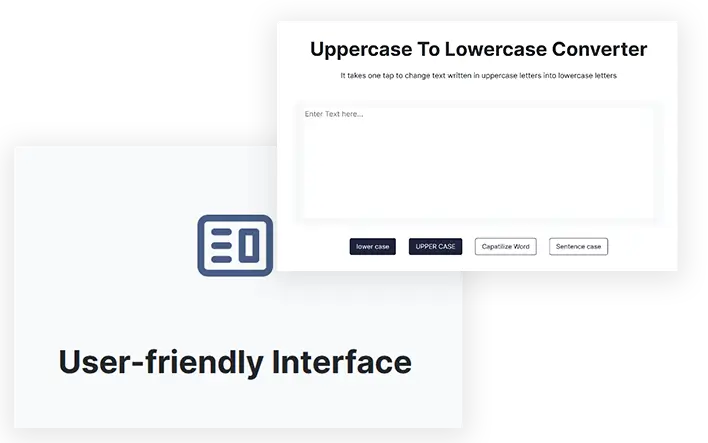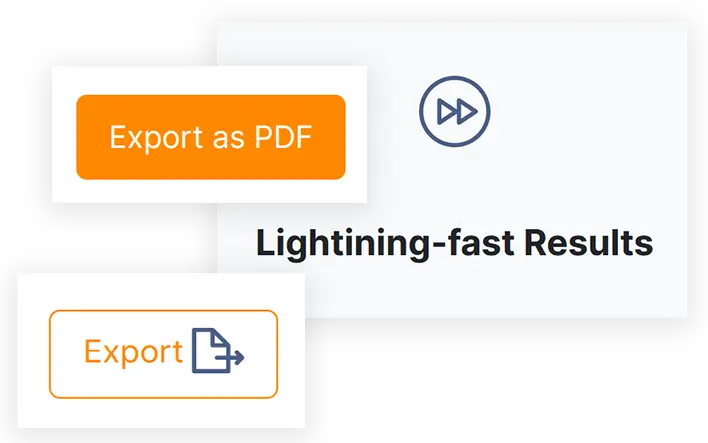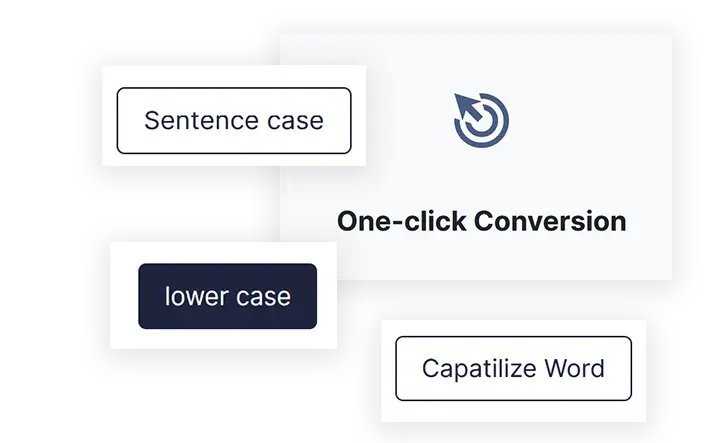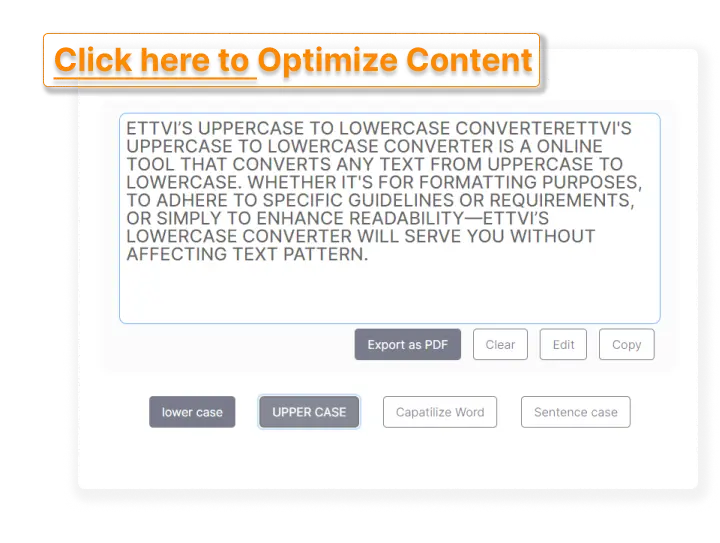Uppercase letters are capitalized, while lowercase letters are small. They are used for proper grammar, readability, and emphasis. Both letter cases are essential for clear communication. Many writing systems use this distinction for better structure.
Uppercase To Lowercase Converter
It takes one tap to change text written in uppercase letters into lowercase letters
Features

User-friendly Interface

One-click Conversion

Lightining-fast Results
Related Tools
ETTVI’s Uppercase to Lowercase Converter
ETTVI's Uppercase to Lowercase Converter is a online tool that converts any text from uppercase to lowercase. Whether it's for formatting purposes, to adhere to specific guidelines or requirements, or simply to enhance readability—ETTVI’s lowercase converter will serve you without affecting text pattern.
ETTVI's Uppercase to Lowercase Converter is also fast and reliable—capable of processing large amounts of text quickly and accurately. This makes it perfect for data entry specialists, students, webmasters, or bloggers who need to convert uppercase to lowercase letters on a regular basis.
ETTVI's Uppercase to Lowercase Converter is an essential text tool to have at your fingertips—for free of cost. It takes only a couple of clicks to change the lettercases. Simply enter the text you want to convert, click the "Convert” button, and your text will be transformed into all lowercase letters.

How to Use ETTVI’s Lettercase Converter?
Here’s how you can convert uppercase to lowercase letters using ETTVI’s tool:
Enter Your Content
First of all, write down or paste the text whose lettercases you are required to change from uppercase to lower.
Convert The Lettercase
Click on “Convert” button to run ETTVI’s uppercase to lowercase tool and start the conversion process right away.
Copy To Clipboard
Wait for a few seconds until the converted text appears on the screen. Click on “Copy” button to save it for later use.

Exploring the World of Lettercase: Types and Styles
In written communication, a letter case is a powerful tool that helps to convey meaning, establish hierarchy, and create visual interest. Understanding the different types and styles of letter cases is essential for effective written communication.
Whether you're writing a formal report or an informal email, using letter cases can make a big difference in how your message is received and understood.
Let's take a closer look at the different types and styles of letter cases:
Uppercase and Lowercase Letters
The two main types of letter cases are uppercase and lowercase letters. Uppercase letters are typically used at the beginning of a sentence or for proper nouns and acronyms, while lowercase letters are used for the rest of the text. This distinction is essential for organizing information and guiding the reader's eye.
Stylistic Forms of Letter cases
In addition to the standard uppercase and lowercase letters, there are several stylistic forms of letter case that can be used to add visual interest and emphasis. Each of these stylistic forms of letter case can be used to create a distinct visual style and tone, depending on the context and purpose of the writing.
These include the following types:
1- Title Case
Capitalizing the first letter of each word in a title, except for certain words such as conjunctions and prepositions. This style is commonly used for book titles, headlines, and subheadings.
2- Camel Case
Capitalizing the first letter of each word in a compound word or phrase, with no spaces between the words. This style is often used in branding and product names, such as iPhone and PowerPoint.
3- Sentence Case
Capitalizing only the first letter of the first word in a sentence and using lowercase for the rest of the text. Academic papers and email communications use this style by default.
4- All-Caps
It is recommended to use only uppercase letters throughout the entire text. Advertising or signage often uses this style to highlight a point of emphasis, such as a headline.
5- Small Caps
Using smaller-sized uppercase letters for the text. This style is a subtle way to add emphasis without using bold or italic fonts.

The Role of Lettercase in Written Language
In the written language, letter case, also known as capitalization, is a fundamental feature of a written sentence. On the whole, letter case plays a critical role in written language and helps to facilitate effective communication in various contexts.
The following are a few examples of how letter case is used in writing:
Differentiating Between Uppercase & Lowercase Letters
Uppercase letters are typically used at the beginning of a sentence or for proper nouns, while lowercase letters are used in the rest of the text. This distinction helps to break up text and provide visual cues that aid in reading comprehension.
Conveying Meaning With Letter case
The use of letters can help to clarify the intended meaning of a word. For example, capitalizing the word "Apple" can indicate that it refers to the company while using a lowercase "a" indicates the fruit. This is particularly useful for avoiding confusion and misunderstandings in written communication.
Letter Case in Programming
In programming, letter case is often used to differentiate between different types of variables or functions. Using consistent letter case conventions can help to ensure that code is easy to read and understand, which is essential for collaborative coding projects.
What Are The Reasons For Changing Case Letters?
The following are some situations when it may be necessary to convert uppercase letters to lowercase, in order to avoid confusion:
- To maintain consistency in a document, you may opt to convert all capital letters to lowercase or vice versa.
- When formatting a document, adhering to a specific style guide or formatting requirement may entail changing uppercase letters to lowercase.
- During proofreading, if some words are in all uppercase, changing them to lowercase may enhance readability.
- In software development or website design, converting user input from uppercase to lowercase or vice versa may ensure consistency and accuracy.
- In optimizing a website for search engines, transforming uppercase letters to lowercase in page URLs or meta tags can potentially enhance search engine rankings.

Frequently Ask Questions
What Is Uppercase and Lowercase?
Why Do We Use Both Uppercase and Lowercase?
Uppercase letters highlight important words, while lowercase improves readability. This distinction makes text easier to understand. Proper capitalization follows grammar rules for professional writing. It helps create structured and clear content.
What is the function of converting text to uppercase?
The UPPER() function in programming changes text to all uppercase. It is commonly used in spreadsheets, databases, and coding. This function helps format text consistently. Ettvi’s converter easily transforms text to uppercase or lowercase.
Is there a limit to the amount of text that can be converted using this tool?
There is no specified limit to the amount of text that can be converted using ETTVI's uppercase to lowercase converter. You can it as required without worrying about slowdowns or delays.
Does ETTVI's uppercase to lowercase converter save any of converted text?
No, ETTVI's uppercase to lowercase converter does not save any of the text that is converted.

Stay up to date in the email world.
Subscribe for weekly emails with curated articles, guides, and videos to enhance your tactics.
